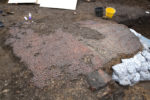 Last winter, University of Leicester archaeologists unearthed a mosaic floor from the Roman era that is one of the largest found in Leicester in three decades. In the winter of 2016/2017, a site on the corner of Highcross Street and Vaughan Way was slated for development, so the ULAS team was engaged by to survey it before construction of new apartment blocks began to perform any necessary salvage of archaeological remains. When they found the remains of a Roman house with a big fragment of a late 3rd or early 4th century A.D. mosaic surviving, they realized they’d have to remove it to save it.
Last winter, University of Leicester archaeologists unearthed a mosaic floor from the Roman era that is one of the largest found in Leicester in three decades. In the winter of 2016/2017, a site on the corner of Highcross Street and Vaughan Way was slated for development, so the ULAS team was engaged by to survey it before construction of new apartment blocks began to perform any necessary salvage of archaeological remains. When they found the remains of a Roman house with a big fragment of a late 3rd or early 4th century A.D. mosaic surviving, they realized they’d have to remove it to save it.
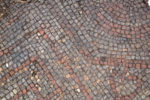 This was not a simple proposition. At two by three meters (6.6 x 9.8 feet) in size, it is impressively large even though it’s just a fragment of the original floor which would have been three times larger and covered the entire square room. The tesserae are small cubes of stone and brick arranged in a square of grey tiles surrounded by border of red. With the central square are red accents, among them a floral motif, leaves and a Swastika meander border.
This was not a simple proposition. At two by three meters (6.6 x 9.8 feet) in size, it is impressively large even though it’s just a fragment of the original floor which would have been three times larger and covered the entire square room. The tesserae are small cubes of stone and brick arranged in a square of grey tiles surrounded by border of red. With the central square are red accents, among them a floral motif, leaves and a Swastika meander border.
It’s handsome, but it’s not a glamorous floor like one of Leicester’s best known Roman remains, the Blackfriars Mosaic which is one the largest and most elaborate mosaic floors ever discovered in Britain. This is the type of floor most houses in Leicester would have during the Roman era.
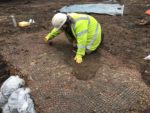 Because it wasn’t the highest quality mosaic like you’d find in the villas of the very wealthy elite, the tesserae were fragile and after 1,500 years or so underground, the mortar that adhered them to the floor and each other was long gone. This made the job of lifting the mosaic a difficult one for the ULAS archaeologists. Archaeological conservator Theo Sturge, who was part of the team who lifted the Blackfriars Mosaic in the 1970s, contributed his extensive expertise to the challenging logistics of lifting a large, barely held-together mosaic in snowy, rainy, cold winter weather.
Because it wasn’t the highest quality mosaic like you’d find in the villas of the very wealthy elite, the tesserae were fragile and after 1,500 years or so underground, the mortar that adhered them to the floor and each other was long gone. This made the job of lifting the mosaic a difficult one for the ULAS archaeologists. Archaeological conservator Theo Sturge, who was part of the team who lifted the Blackfriars Mosaic in the 1970s, contributed his extensive expertise to the challenging logistics of lifting a large, barely held-together mosaic in snowy, rainy, cold winter weather.
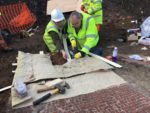 Thousands of tesserae had to be lifted in such a way to ensure none of them would be displaced and the pattern disrupted. To make this happen, especially in the atrocious weather conditions, ULAS had to glue Hessian fabric to the surface of the mosaic. Whatever remained of the mortar grout between the tesserae and the mortar base onto which the tiles had been set were cut away and thin boards placed underneath sections of the mosaic. The boards were then lifted and the mosaic was moved, section by section, to Theo Sturges’ laboratory for conservation.
Thousands of tesserae had to be lifted in such a way to ensure none of them would be displaced and the pattern disrupted. To make this happen, especially in the atrocious weather conditions, ULAS had to glue Hessian fabric to the surface of the mosaic. Whatever remained of the mortar grout between the tesserae and the mortar base onto which the tiles had been set were cut away and thin boards placed underneath sections of the mosaic. The boards were then lifted and the mosaic was moved, section by section, to Theo Sturges’ laboratory for conservation.
[ULAS Project Officer] Mathew Morris added: “The finished mosaic looks fantastic, Theo has done an amazing job putting it back together. In some ways it’s quite unusual to go to this level of effort and cost to conserve a mosaic of this quality, but actually because of its poorer quality you can see the craftsmanship behind it. You can see the direction the Roman workers were laying the stones in, you can see at one point one of the lines started to bend off and so they’ve had to turn one line into three to create a straight edge again. It’s these little human touches and errors that you can see in it that are important because they give you those glimpses into how it was made, who made it and their attitude to work, that gives you that real insight into the people of Roman Leicester.”
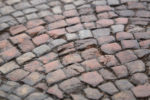 Its conservation complete, the mosaic is back in Leicester where it will go on display at a future date and location yet to be determined. In anticipation of the upcoming exhibition, ULAS has just released a very cool video describing the lifting and conservation of the mosaic.
Its conservation complete, the mosaic is back in Leicester where it will go on display at a future date and location yet to be determined. In anticipation of the upcoming exhibition, ULAS has just released a very cool video describing the lifting and conservation of the mosaic.
I wonder where they got the brick for the mosaic – from old buildings or rejects from the brick maker?
The brick tesserae were probably taken from both, i.e. old buildings and brick makers, but I am not sure if would it really would work to cut brick into tesserae/ cubes.
Of course, clay is not stone. I have seen fresher black and white mosaics in Lisbon and Rhodes (seemingly from the 1790ies), and that ‘white’ stone might have been in fact much whiter.
Alternatively, with brick making, there might have been clay leftovers and space in the furnace that had to be filled (as fresh clay is easier to process).
That’s great that they were able to preserve a more typical home’s mosaic. We get excited about the fancy expensive ones but it’s good to have ‘lesser’ examples remaining and available for study as well.
Trevor–they had endless manpower, so cutting down a brick wouldn’t be an issue. But they were also practical. They probably cast them by the zillion, to be sold cheaply to the people who could afford them.
Yes, a mix of sources for the brick sounds like good practical sense. My father was a bricklayer, and I often saw him cut a brick down with nothing more than a hammer and a very wide and thin chisel. He also described how it was the apprentice’s job to grind the cut brick to its final size and finish for those fancy window openings and chimneys that buildings often used to have.
“What have the Romans ever done for us?”
https://www.youtube.com/watch?v=uvPbj9NX0zc
ht tps://www.youtube.com/watch?v=uvPbj9NX0zc
What have the Romans ever done for us?